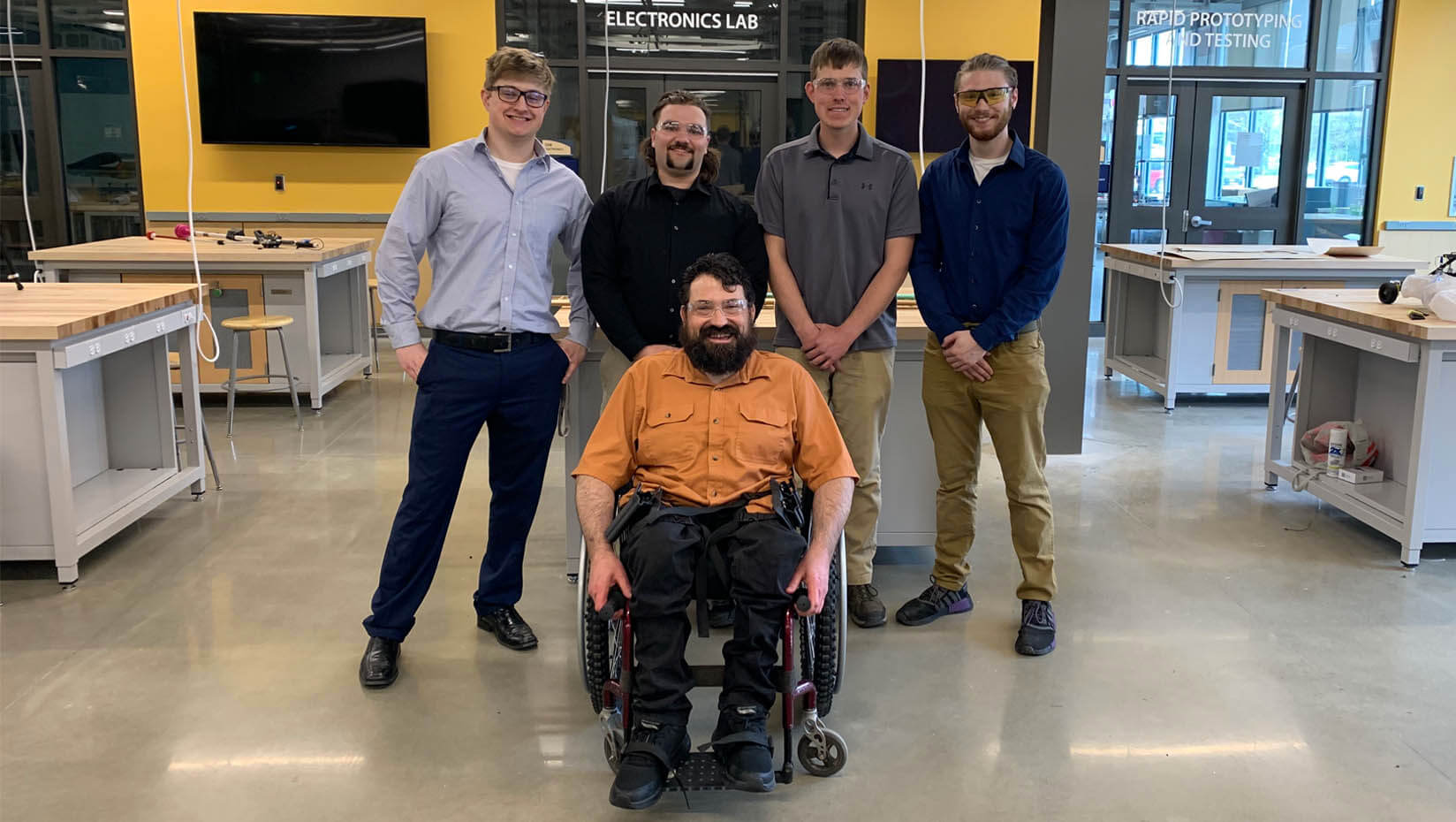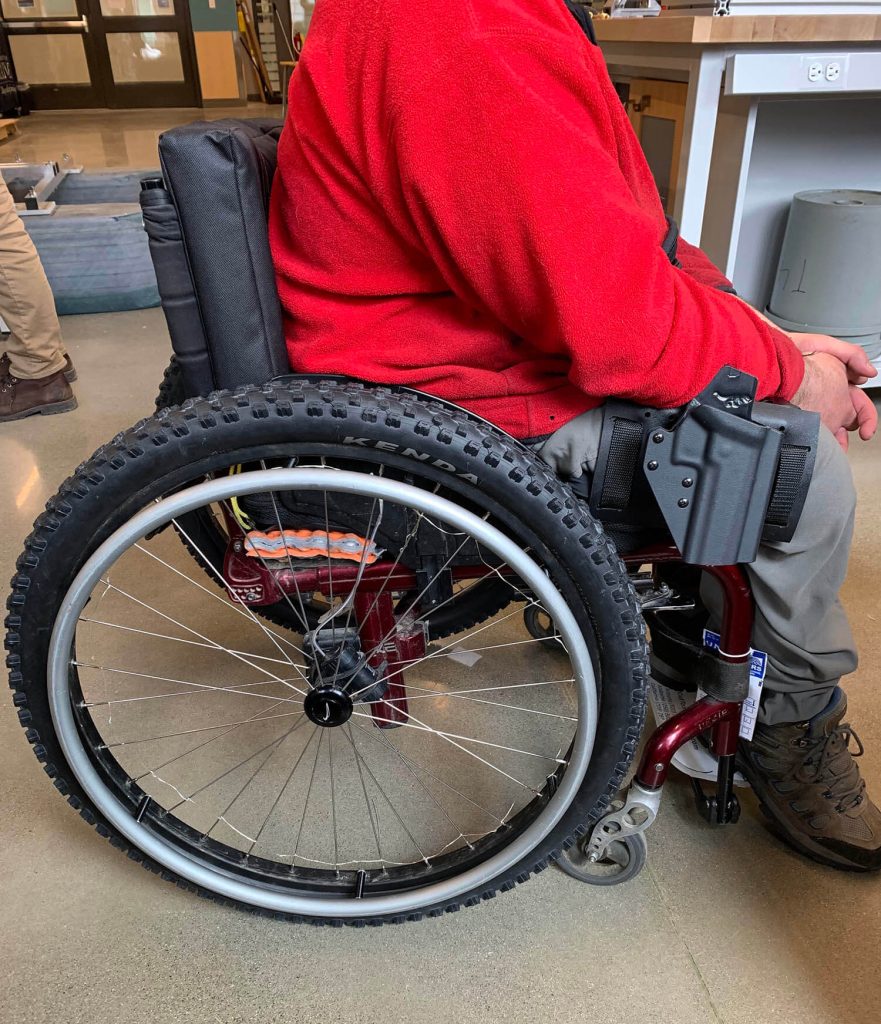
UMaine MET students designed an adaptive wheelchair for shooting competitions
The University of Maine’s Mechanical Engineering Technology (MET) program is all about real-world problem solving. When athlete and activist Enock Glidden came to the MET capstone with a unique challenge — to adapt his wheelchair for shooting competitions — students met the task with skill, creativity and an open-mindedness that resulted in a useful finished project, and a lifelong bond.
All students in the MET major are required to take the yearlong capstone class. The capstone offers students a variety of real-world projects to choose from. This past year, that included restoring an old lathe, a pedal powered catamaran, a robotic mouse trap, a 3D printed rocket nozzle and more.
One of the projects offered to students was to work with Glidden, an activist who catalogs his adventures and athletic endeavors in his wheelchair through the website Go Beyond the Fence. Glidden, who grew up in Maine and earned his degree from the University of Maine at Augusta (where he recently returned as the 2023 Commencement speaker), started entering adaptive shooting competitions about four years ago. He used to go shooting with his dad when he was younger, and liked the independence that the sport offered.
“Normally when I do something adaptive it has to involve a whole bunch of people or someone helping me,” Glidden says. “With adaptive shooting I can just go up to a range. I don’t need a whole bunch of help except a firearm and ammunition.”
Shooting from a wheelchair still presents a few challenges, though. The ranges have rough terrain that are difficult for wheelchair wheels to traverse. Glidden has a tendency to lean forward when holding heavy objects in front of him like a firearm, and the recoil from the gun throws off his stance and makes it difficult for him to lock on to the next target.

Glidden described these issues to his friend and MET alumna Kim Lawton, who knew that UMaine MET students would be more than up to the task of helping him solve these issues through intelligent engineering. Keith Berube, associate professor of mechanical engineering technology who co-teaches the MET capstone class, was thrilled to add the project to the capstone lineup.
“We love there to be a community outreach portion of our senior capstone projects, but they are often difficult to come by, so we were thrilled when Kim approached us in August 2022 about this project,” Berube says. “These types of projects are usually the more popular options with our students as well.”
Four students signed up for the project: Conor Stevens, Alexander Hyde, James Terrill and Hunter Quirrion. They met virtually with Glidden to determine what adjustments needed to be made to his existing apparatus. Stevens, who was drawn to the project because he had competed in shooting sports himself, even joined Glidden at the range in Hollis to see the technical challenges first-hand.
The students narrowed their tasks down to a few key areas: a magnetic footplate to hold Glidden’s feet in place, a holster, a backrest to push him forward into a more comfortable shooting position, a propulsion system with lever arm action instead of push rims and improved tires for the terrain. The students divided up the responsibilities on the project between them and got to work — and they were really starting from scratch.
“The wheelchair industry is relatively small and it gets even smaller when you get to competition shooting from the wheelchair,” says Stevens. “There weren’t a whole lot of resources. We couldn’t really use wheelchair specific components; everything for wheelchairs is really expensive. We had to come up with a way to make our own.”
Student teams in the MET capstone are given a budget of $150 to help them purchase needed materials. But this team had an ambitious vision for their project — so they reached out to community partners for support. T.Rex Arms provided holsters, the Advanced Structures and Composites Center donated water jet cutting services, Bangor Steel provided material and Rose Bike in Orono helped hook the young engineers up with wheelchair-sized wheels with extra heft and treads.
Jim Rose, owner of Rose Bike who graduated from UMaine in 1983, says that he has helped with projects like this in the past, and hopes to continue doing so in the future.
“We’re always excited to do these things,” Rose says. “We enjoy doing that and we try to offer some discounts if they’re using used parts. It’s a great way to learn. A lot of the simple technologies for bicycles can be used for a lot of other applications.”
Some of the elements were harder to figure out than others, particularly the propulsion system with the lever arm action, but allowing students to figure things out for themselves is part of the learning process in the MET capstone. Quirron says that the advisers in the MET capstone “let you flounder a little bit and then helped you get up and make sure you were on the right path.”
“This year’s team did an excellent job of determining the needs of the client, exploring engineering options, and then producing solutions that met those needs,” Berube says.
At the end of the course, the students met with Glidden in person to add their new components to his wheelchair and watch him test it. Hyde says the experience was nerve-wracking for the fledgling engineers.
“We’re kind of working with sensitive technology because it was all engineered for him,” he says. “We didn’t really want to mess up what he had going on in his wheelchair.”
Despite their nerves, Glidden was impressed with the results.
“They were really very professional. They took really good care of my wheelchair and things were going to be as good as possible when they were finished,” Glidden says. “A lot of things came out of it that other people might use: the bigger tires, the pad behind my back, they made really good side guards that I wanted my entire life, the magnets on my feet plate. Most of the modifications did exactly what they wanted and I’ll keep using them.”
To cap off the experience, Glidden invited the team of students to a shooting event that he held with his club, the Great Equalizer Challenge, where every participant had to compete in a wheelchair. He showed off his new chair, and the students also had the opportunity to try to navigate the course in wheelchairs themselves, to see what a challenge it really is and the difference that their engineering made.
“He was laughing so hard at all of us trying to move around in the dirt that normally don’t use wheelchairs. I almost went over and face-planted several times,” Stevens says. “Going through a series of stages shooting from a wheelchair, I definitely learned a lot.”
The students who worked on the project say that the capstone project has come up in every job interview they have had since. Even beyond the job prospects, though, this capstone project will always be a valuable memory for these young engineers.
“The biggest thing for me was seeing the big smile on his face when he was rolling around in the wheelchair with everything on. That was amazing,” Stevens says. “It was really good being able to make a difference to someone who would be able to appreciate it.”
Contact: Sam Schipani, samantha.schipani@maine.edu
